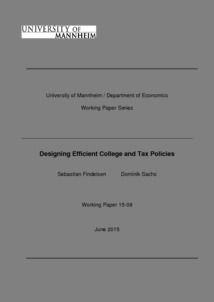|
Designing efficient college and tax policies
Findeisen, Sebastian
;
Sachs, Dominik
![[img]](https://madoc.bib.uni-mannheim.de/style/images/fileicons/application_pdf.png)  Vorschau |
|
PDF
Findeisen_und_Sachs_15-09.pdf
- Veröffentlichte Version
Download (868kB)
|
|
URL:
|
https://ub-madoc.bib.uni-mannheim.de/39005
|
|
URN:
|
urn:nbn:de:bsz:180-madoc-390055
|
|
Dokumenttyp:
|
Arbeitspapier
|
|
Erscheinungsjahr:
|
2015
|
|
Titel einer Zeitschrift oder einer Reihe:
|
Working Paper Series
|
|
Band/Volume:
|
15-09
|
|
Ort der Veröffentlichung:
|
Mannheim
|
|
Sprache der Veröffentlichung:
|
Englisch
|
|
Einrichtung:
|
Fakultät für Rechtswissenschaft und Volkswirtschaftslehre > VWL, Makro- u. Entwicklungsökonomie (Juniorprofessur) (Findeisen 2014-2019)
|
|
MADOC-Schriftenreihe:
|
Department of Economics > Working Paper Series
|
|
Fachgebiet:
|
330 Wirtschaft
|
|
Fachklassifikation:
|
JEL:
H21 , H23 , I22 , I24 , I28,
|
|
Freie Schlagwörter (Englisch):
|
Optimal Taxation , College Subsidies , College Enrollment , Tax Reforms
|
|
Abstract:
|
The total social benefits of college education exceed the private benefits because the
government receives a share of the monetary returns in the form of income taxes. We
study the policy implications of this fiscal externality in an optimal dynamic tax framework.
Using a variational approach we derive a formula for the revenue effect of an increase
in college education subsidies and for the excess burden of income taxation caused by the
college margin. We also show how the optimal nonlinear income tax problem is altered by
the college margin. Our modeling assumptions are strongly guided by the recent structural
labor literature on college education. The model incorporates multidimensional heterogeneity,
idiosyncratic risk and borrowing constraints. The model matches key empirical
results on college enrollment patterns, returns to education and enrollment elasticities.
Quantitatively, we find that a marginal increase in college subsidies in the US is at least
70 percent self-financing through the net-present value increase in future tax revenue.
When targeting this increase to children in the lowest parental income tercile, it is even
up to 165 percent self-financing. The excess burden of income taxation is only slightly
altered by the college margin and therefore the optimal Mirrleesian income tax schedule
is barely affected as well, in particular if subsidies are set at their optimal level.
|
 | Dieser Eintrag ist Teil der Universitätsbibliographie. |
 | Das Dokument wird vom Publikationsserver der Universitätsbibliothek Mannheim bereitgestellt. |
 Suche Autoren in Suche Autoren in
Sie haben einen Fehler gefunden? Teilen Sie uns Ihren Korrekturwunsch bitte hier mit: E-Mail
Actions (login required)
 |
Eintrag anzeigen |
|
|
